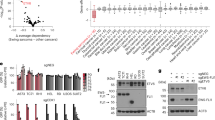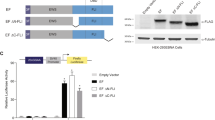Abstract
The polycomb group family protein BMI-1 is overexpressed by and functions as an oncogene in many different human cancers. We have previously shown that BMI-1 promotes the tumorigenicity of Ewing sarcoma family tumors (ESFTs) and that this is mediated independently of CDKN2A repression. In this study, we have discovered that high levels of BMI-1 confer resistance to contact inhibition in ESFT cells. Using stable retroviral transduction, we evaluated the consequences of BMI-1 knockdown on the growth of CDKN2A wild-type and mutant ESFT cells in subconfluent and confluent conditions. Although knockdown of BMI-1 had no effect on proliferation in low-density cultures, at high cell densities it resulted in cell cycle arrest and death. The normal cell contact inhibition response is mediated, in large part, by the recently described Hippo pathway which functions to inhibit cell proliferation and promote cell death by inactivating the Yes-Associated Protein (YAP). Significantly, we found that YAP levels, activity and expression did not diminish in confluent ESFT cells that expressed high levels of BMI-1. In contrast, YAP expression and nuclear localization were reduced in confluent BMI-1 knockdown cells suggesting that silencing of BMI-1 restored contact inhibition by restoring normal activation of the Hippo–YAP growth-suppressor pathway. Importantly, knockdown of YAP in ESFT cells resulted in profound inhibition of cell proliferation and anchorage-independent colony formation suggesting that stabilization and continued expression of YAP is critical for ESFT growth and tumorigenicity. Together, these studies reveal a previously unrecognized link between BMI-1, contact inhibition and the Hippo–YAP pathway and suggest that resistance to contact inhibition in BMI-1 overexpressing cancer cells may be in part a result of Hippo inhibition and aberrant stabilization of YAP.
This is a preview of subscription content, access via your institution
Access options
Subscribe to this journal
Receive 50 print issues and online access
$259.00 per year
only $5.18 per issue
Buy this article
- Purchase on Springer Link
- Instant access to full article PDF
Prices may be subject to local taxes which are calculated during checkout




Similar content being viewed by others
References
Abercrombie M . (1979). Contact inhibition and malignancy. Nature 281: 259–262.
Abercrombie M, Ambrose EJ . (1958). Interference microscope studies of cell contacts in tissue culture. Exp Cell Res 15: 332–345.
Abercrombie M, Heaysman JE . (1954). Observations on the social behaviour of cells in tissue culture. II. Monolayering of fibroblasts. Exp Cell Res 6: 293–306.
Badouel C, Gardano L, Amin N, Garg A, Rosenfeld R, Le Bihan T et al. (2009). The FERM-domain protein Expanded regulates Hippo pathway activity via direct interactions with the transcriptional activator Yorkie. Dev Cell 16: 411–420.
Balamuth NJ, Womer RB . (2010). Ewing's sarcoma. Lancet Oncol 11: 184–192.
Ban J, Siligan C, Kreppel M, Aryee D, Kovar H . (2006). EWS-FLI1 in Ewing's sarcoma: real targets and collateral damage. Adv Exp Med Biol 587: 41–52.
Baumgartner R, Poernbacher I, Buser N, Hafen E, Stocker H . (2010). The WW domain protein Kibra acts upstream of hippo in Drosophila. Dev Cell 18: 309–316.
Bracken AP, Helin K . (2009). Polycomb group proteins: navigators of lineage pathways led astray in cancer. Nat Rev Cancer 9: 773–784.
Bruggeman SW, Hulsman D, Tanger E, Buckle T, Blom M, Zevenhoven J et al. (2007). Bmi1 controls tumor development in an Ink4a/Arf-independent manner in a mouse model for glioma. Cancer Cell 12: 328–341.
Camargo FD, Gokhale S, Johnnidis JB, Fu D, Bell GW, Jaenisch R et al. (2007). YAP1 increases organ size and expands undifferentiated progenitor cells. Curr Biol 17: 2054–2060.
Chatoo W, Abdouh M, David J, Champagne MP, Ferreira J, Rodier F et al. (2009). The polycomb group gene Bmi1 regulates antioxidant defenses in neurons by repressing p53 pro-oxidant activity. J Neurosci 29: 529–542.
Datta S, Hoenerhoff MJ, Bommi P, Sainger R, Guo WJ, Dimri M et al. (2007). Bmi-1 cooperates with H-Ras to transform human mammary epithelial cells via dysregulation of multiple growth-regulatory pathways. Cancer Res 67: 10286–10295.
Douglas D, Hsu JH, Hung L, Cooper A, Abdueva D, van Doorninck J et al. (2008). BMI-1 promotes ewing sarcoma tumorigenicity independent of CDKN2A repression. Cancer Res 68: 6507–6515.
Eagle H, Levine EM . (1967). Growth regulatory effects of cellular interaction. Nature 213: 1102–1106.
Fernandez LA, Northcott PA, Dalton J, Fraga C, Ellison D, Angers S et al. (2009). YAP1 is amplified and up-regulated in hedgehog-associated medulloblastomas and mediates Sonic hedgehog-driven neural precursor proliferation. Genes Dev 23: 2729–2741.
Genevet A, Wehr MC, Brain R, Thompson BJ, Tapon N . (2010). Kibra is a regulator of the salvador/warts/hippo signaling network. Dev Cell 18: 300–308.
Gil J, Bernard D, Peters G . (2005). Role of polycomb group proteins in stem cell self-renewal and cancer. DNA Cell Biol 24: 117–125.
Hamaratoglu F, Willecke M, Kango-Singh M, Nolo R, Hyun E, Tao C et al. (2006). The tumour-suppressor genes NF2/Merlin and Expanded act through Hippo signalling to regulate cell proliferation and apoptosis. Nat Cell Biol 8: 27–36.
Jacobs JJ, Kieboom K, Marino S, DePinho RA, van Lohuizen M . (1999a). The oncogene and Polycomb-group gene bmi-1 regulates cell proliferation and senescence through the ink4a locus. Nature 397: 164–168.
Jacobs JJ, Scheijen B, Voncken JW, Kieboom K, Berns A, van Lohuizen M . (1999b). Bmi-1 collaborates with c-Myc in tumorigenesis by inhibiting c-Myc-induced apoptosis via INK4a/ARF. Genes Dev 13: 2678–2690.
Lian I, Kim J, Okazawa H, Zhao J, Zhao B, Yu J et al. (2010). The role of YAP transcription coactivator in regulating stem cell self-renewal and differentiation. Genes Dev 24: 1106–1118.
Lim R, Nakagawa S, Arnason BG, Turriff DE . (1981). Glia maturation factor promotes contact inhibition in cancer cells. Proc Natl Acad Sci USA 78: 4373–4377.
Liu J, Cao L, Chen J, Song S, Lee IH, Quijano C et al. (2009). Bmi1 regulates mitochondrial function and the DNA damage response pathway. Nature 459: 387–392.
Meltzer PS . (2007). Is Ewing's sarcoma a stem cell tumor? Cell Stem Cell 1: 13–15.
Morrison H, Sherman LS, Legg J, Banine F, Isacke C, Haipek CA et al. (2001). The NF2 tumor suppressor gene product, merlin, mediates contact inhibition of growth through interactions with CD44. Genes Dev 15: 968–980.
Oguro H, Yuan J, Ichikawa H, Ikawa T, Yamazaki S, Kawamoto H et al. (2010). Poised lineage specification in multipotential hematopoietic stem and progenitor cells by the polycomb protein Bmi1. Cell Stem Cell 6: 279–286.
Parrish JZ, Emoto K, Jan LY, Jan YN . (2007). Polycomb genes interact with the tumor suppressor genes hippo and warts in the maintenance of Drosophila sensory neuron dendrites. Genes Dev 21: 956–972.
Pietersen AM, Evers B, Prasad AA, Tanger E, Cornelissen-Steijger P, Jonkers J et al. (2008). Bmi1 regulates stem cells and proliferation and differentiation of committed cells in mammary epithelium. Curr Biol 18: 1094–1099.
Richter GH, Plehm S, Fasan A, Rossler S, Unland R, Bennani-Baiti IM et al. (2009). EZH2 is a mediator of EWS/FLI1 driven tumor growth and metastasis blocking endothelial and neuro-ectodermal differentiation. Proc Natl Acad Sci USA 106: 5324–5329.
Rodesch F . (1973). Differentiation, contact inhibition and intercellular communication in retinal pigment cells. Exp Cell Res 76: 55–62.
Silletti S, Yao JP, Pienta KJ, Raz A . (1995). Loss of cell-contact regulation and altered responses to autocrine motility factor correlate with increased malignancy in prostate cancer cells. Int J Cancer 63: 100–105.
Snijders AM, Schmidt BL, Fridlyand J, Dekker N, Pinkel D, Jordan RC et al. (2005). Rare amplicons implicate frequent deregulation of cell fate specification pathways in oral squamous cell carcinoma. Oncogene 24: 4232–4242.
Striedinger K, VandenBerg SR, Baia GS, McDermott MW, Gutmann DH, Lal A . (2008). The neurofibromatosis 2 tumor suppressor gene product, merlin, regulates human meningioma cell growth by signaling through YAP. Neoplasia 10: 1204–1212.
Tirode F, Laud-Duval K, Prieur A, Delorme B, Charbord P, Delattre O . (2007). Mesenchymal stem cell features of Ewing tumors. Cancer Cell 11: 421–429.
Wiederschain D, Chen L, Johnson B, Bettano K, Jackson D, Taraszka J et al. (2007). Contribution of polycomb homologues Bmi-1 and Mel-18 to medulloblastoma pathogenesis. Mol Cell Biol 27: 4968–4979.
Yu J, Zheng Y, Dong J, Klusza S, Deng WM, Pan D . (2010). Kibra functions as a tumor suppressor protein that regulates hippo signaling in conjunction with Merlin and expanded. Dev Cell 18: 288–299.
Zender L, Spector MS, Xue W, Flemming P, Cordon-Cardo C, Silke J et al. (2006). Identification and validation of oncogenes in liver cancer using an integrative oncogenomic approach. Cell 125: 1253–1267.
Zhang N, Bai H, David KK, Dong J, Aheng Y, Cai J et al. (2010). The Merlin/NF2 Tumor Suppressor Functions through the YAP Oncoprotein to Regulate Tissue Homeostasis in Mammals. Developmental Cell 19: 27–38.
Zhao B, Li L, Lei Q, Guan KL . (2010a). The Hippo-YAP pathway in organ size control and tumorigenesis: an updated version. Genes Dev 24: 862–874.
Zhao B, Li L, Tumaneng K, Wang CY, Guan KL . (2010b). A coordinated phosphorylation by Lats and CK1 regulates YAP stability through SCF(beta-TRCP). Genes Dev 24: 72–85.
Acknowledgements
We gratefully acknowledge Long Hung and Asim Beg for technical support, members of the Lawlor lab for helpful discussion, Dr T Triche and the Children's Oncology Cell Bank (COGCELL.org) for cell lines. This work was initiated at Childrens Hospital Los Angeles (CHLA) with support from the TJ Martell Foundation. JHH was supported by CIRM training Grant T1-00004 and ERL by NIH/NCI 1R01CA134604-01. Grant support: California Institute for Regenerative Medicine Training Grant T1-00004 (JHH), 1R01CA134604-01 (ERL).
Author information
Authors and Affiliations
Corresponding author
Ethics declarations
Competing interests
The authors declare no conflict of interest.
Additional information
Supplementary Information accompanies the paper on the Oncogene website
Rights and permissions
About this article
Cite this article
Hsu, J., Lawlor, E. BMI-1 suppresses contact inhibition and stabilizes YAP in Ewing sarcoma. Oncogene 30, 2077–2085 (2011). https://doi.org/10.1038/onc.2010.571
Received:
Revised:
Accepted:
Published:
Issue Date:
DOI: https://doi.org/10.1038/onc.2010.571
Keywords
This article is cited by
-
Molecular mechanisms underpinning sarcomas and implications for current and future therapy
Signal Transduction and Targeted Therapy (2021)
-
YAP/TAZ inhibition reduces metastatic potential of Ewing sarcoma cells
Oncogenesis (2021)



